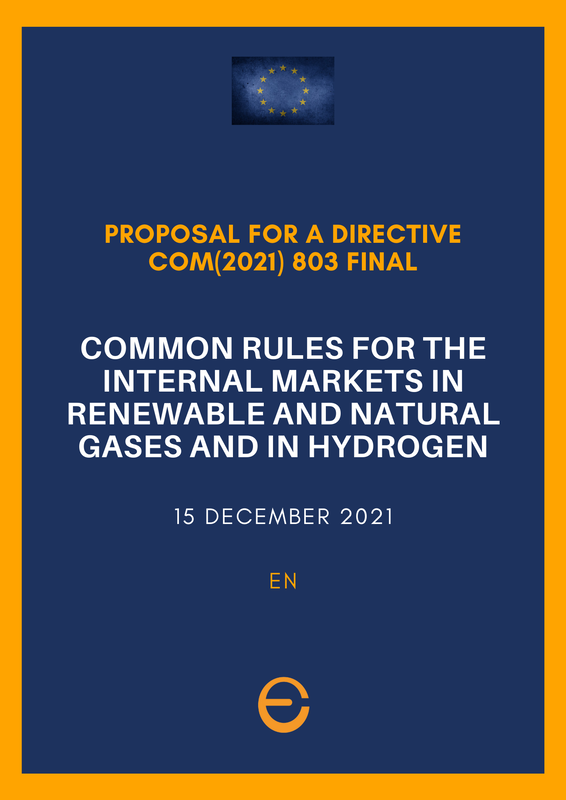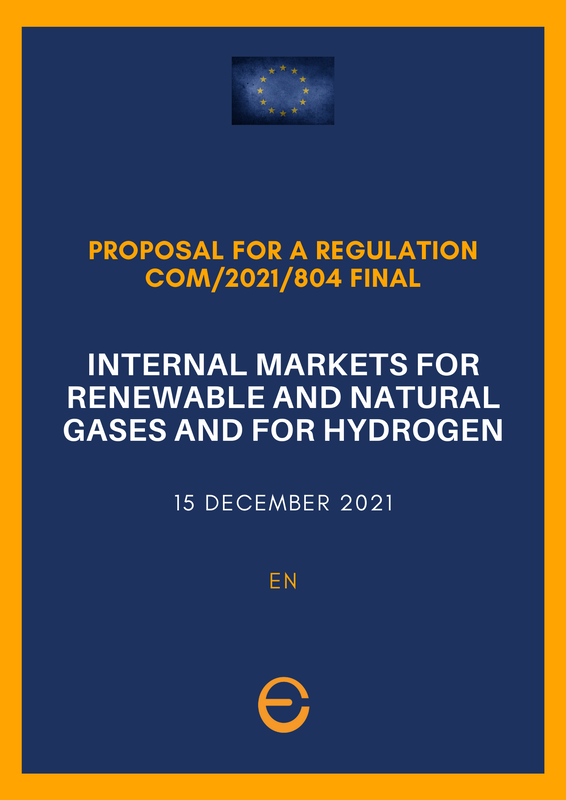Secure Gas Supply
About one quarter of all the energy used in the EU is natural gas and many EU countries import nearly all of their supplies. Some EU countries are also heavily reliant on a single source or a single transport route for the majority of their gas.
As a result of the war in Ukraine in February 2022, EU countries have begun a reflection on how and when to reduce or end their dependence on Russia. Meanwhile, Germany has stopped the authorization procedures for the use of the Nord Stream 2 gas pipeline.
Apart from issues of dependence on Russia, the gas market in Europe is regulated by certain measures to ensure a solid and stable market. Below is the European legislation.
As a result of the war in Ukraine in February 2022, EU countries have begun a reflection on how and when to reduce or end their dependence on Russia. Meanwhile, Germany has stopped the authorization procedures for the use of the Nord Stream 2 gas pipeline.
Apart from issues of dependence on Russia, the gas market in Europe is regulated by certain measures to ensure a solid and stable market. Below is the European legislation.
Preventing gas supply disruptions
Disruptions along single transport routes can threaten the uninterrupted gas supply to some European countries. Gas supply disruptions may result from technical or human failures, natural disasters, cyber-attacks and other emerging risks, as well as from geopolitical disputes.
For example in 2009, a gas dispute between Russia and Ukraine affected gas supplies to some EU countries. In 2017, an explosion at a major European gas hub in Baumgarten (Austria) caused neighbouring countries to issue an early warning, or declare a state of energy emergency.
Then, in the autumn of 2021, the energy price spike triggered questions regarding the EU’s security of supply, due to the interplay between prices, lower than usual storage filling levels and the consistency of availability of gas supplies for the gas system.
To help prevent potential supply disruptions and respond to them if they happen, the EU has agreed on common standards and indicators to assess serious threats and prepare against their impacts. The measures in place allow EU countries to define how much gas is needed to guarantee the supply to households and essential services at all times, also in extreme gas disruption situations.
Disruptions along single transport routes can threaten the uninterrupted gas supply to some European countries. Gas supply disruptions may result from technical or human failures, natural disasters, cyber-attacks and other emerging risks, as well as from geopolitical disputes.
For example in 2009, a gas dispute between Russia and Ukraine affected gas supplies to some EU countries. In 2017, an explosion at a major European gas hub in Baumgarten (Austria) caused neighbouring countries to issue an early warning, or declare a state of energy emergency.
Then, in the autumn of 2021, the energy price spike triggered questions regarding the EU’s security of supply, due to the interplay between prices, lower than usual storage filling levels and the consistency of availability of gas supplies for the gas system.
To help prevent potential supply disruptions and respond to them if they happen, the EU has agreed on common standards and indicators to assess serious threats and prepare against their impacts. The measures in place allow EU countries to define how much gas is needed to guarantee the supply to households and essential services at all times, also in extreme gas disruption situations.
Security of gas supply
Security of gas supply can be achieved with three measures:
Reliable suppliers
As regards the supply of gas, as with all energy raw materials, the Member States are solely responsible for finding suppliers and signing supply contracts. Even in relation to the most recent tensions with Russia, the EU can at most issue recommendations on which supplier countries to rely on. In the present case, the political recommendations have been to reduce dependence on Russia, including by warning member states from paying for their supplies in rubles, as requested by Russia. The moral suasion of the EU to convince member countries to choose other supplier countries means that almost all countries have sought other gas suppliers, but the solutions remain national.
- have reliable suppliers
- have sufficient stocks
- solidarity between member countries
Reliable suppliers
As regards the supply of gas, as with all energy raw materials, the Member States are solely responsible for finding suppliers and signing supply contracts. Even in relation to the most recent tensions with Russia, the EU can at most issue recommendations on which supplier countries to rely on. In the present case, the political recommendations have been to reduce dependence on Russia, including by warning member states from paying for their supplies in rubles, as requested by Russia. The moral suasion of the EU to convince member countries to choose other supplier countries means that almost all countries have sought other gas suppliers, but the solutions remain national.
|
Stocks
The Regulation (EU) 2017/1938 on measures to safeguard the security of gas supply, which repealed Regulation (EU) 994/2010. This Regulation, with a very evasive title, deals with giving indications on the functioning of the gas networks to guarantee full operational efficiency even in the event of turbulence. With Regulation (EU) 2022/1032, amending the aforementioned Regulation, the gas stock levels that each State should guarantee are introduced for the first time:
This Regulation was approved in the aftermath of the war in Ukraine. The other provisions of the Regulation (EU) 2017/1938 are based on improved information exchange, regional cooperation and solidarity, and cover:
|
New regulatory package on renewable and natural gases and for Hydrogen
|
On 27 March 2023, the Council adopted a new Directive on common rules for Internal market for renewable and natural gases and for Hydrogen. The EU Commission adopted a new regulatory package in December 2021:
The proposed Regulation includes amendments to the Security of Gas Supply Regulation ((EU) 2017/1938). These amendments (see Article 67 of the proposed regulation) aim to extend the scope of the regulation to renewable and low carbon gases, while also adapting it to new risks, such as cyber security. Moreover, the amendments will adopt a regional approach to make more efficient use of storage, for example by agreeing on risks and measures in the regional risk groups.
The new storage provisions will also enable voluntary joint procurement of strategic stocks by Transmission System Operators (TSOs), for example in times of emergency. The changes to the existing rules will increase stability, resilience and the EU’s strategic autonomy.
New gas storage level Following Russia’s invasion of Ukraine in the beginning of 2022, the Commission published on 23 March 2022 a Proposal for a Regulation COM(2022) 135 Final, for amendment of Regulation (EU) 2017/1938 including measures to deal with the market imbalances for energy and to ensure well-filled gas storage in the EU. These include a minimum 80% gas storage level obligation by 1 November 2022, rising to 90% for the following years. The proposal highlights how gas storages contribute to security of supply by absorbing supply shocks in case of strong demand or supply disruptions. An important element in this new proposal is the burden sharing mechanism. Some EU countries have storages larger than their own national consumption, while others do not have any storage facilities. However, all EU countries benefit from the guaranteed filling levels, so the burden sharing mechanism makes sure that not only EU countries with storage facilities pay for the security of supply costs of the minimum filling target.
|
|
Solidarity arrangements
A key objective of the regulation is to enable a solidarity mechanism that will come into effect only in the event of an extreme gas crisis. It will help ensure that the most vulnerable consumers continue to have access to gas, even in challenging conditions. EU countries are required to put in place the necessary technical, legal and financial arrangements to make the provision of solidarity gas possible in practice. EU countries must therefore reach bilateral agreements with their neighbours and agree on the next steps, should solidarity gas be needed. The solidarity mechanism is a landmark step in developing the EU’s resilience to gas supply disruptions and it helps realise the solidarity principle that underpins EU energy policy more widely. Similar cooperation and mutual assistance arrangements are foreseen in the electricity sector by the Regulation (EU) 2019/941. on risk-preparedness To facilitate the task of the EU countries, the Commission delivered a Commission Recommendation (EU) 2018/177, a guidance document on the technical, legal and financial elements that should be included in arrangements. The first bilateral solidarity agreement was signed between Germany and Denmark on 14 December 2020, while a second agreement was signed by Germany and Austria on 2 December 2021. |
Preventive action plans and emergency plans
The preventive action plans and emergency plans prepared by EU countries are important tools to guarantee the security of gas supply. Preventive action plans include measures needed to remove or mitigate gas supply risks identified in their national and common risk assessments. Emergency plans on the other hand, cover measures to remove or mitigate the impact of a gas supply disruption. The regulation foresees that plans follow a common structure and contain the same key elements, which makes it easier to compare the plans of different EU countries. It also requires that the preventive and emergency plans must be updated every 4 years and include regional chapters reflecting common risks. You may consult all final plans and Commission opinions.
The preventive action plans and emergency plans prepared by EU countries are important tools to guarantee the security of gas supply. Preventive action plans include measures needed to remove or mitigate gas supply risks identified in their national and common risk assessments. Emergency plans on the other hand, cover measures to remove or mitigate the impact of a gas supply disruption. The regulation foresees that plans follow a common structure and contain the same key elements, which makes it easier to compare the plans of different EU countries. It also requires that the preventive and emergency plans must be updated every 4 years and include regional chapters reflecting common risks. You may consult all final plans and Commission opinions.
Gas Coordination Group
The Gas Coordination Group is a standing advisory group, coordinating security of supply measures, especially during crises. The group assists the Commission on monitoring the adequacy and appropriateness of measures to be taken under the regulation, as well as serving as a platform for the exchange of information on security of gas supply between key stakeholders. In addition, the Gas Coordination Group continuously monitors the storage levels and security of supply throughout the EU and its neighborhood. The group meets regularly to discuss these matters.
Members include national authorities, the Agency for the Cooperation of Energy Regulators (ACER), the European Network of Transmission System Operators for Gas (ENTSOG), the Energy Community and representatives of industry and consumer associations.








